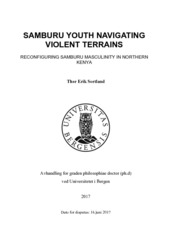| dc.description.abstract | This thesis is part of the major research project The effects of violence and impoverishment on psychosocial health among pastoralist communities in Northern Kenya funded by The Research Council of Norway. Based on a multisided fieldwork in Northern Kenya, this thesis examines how young Samburu men reconfigure their masculinity. These young men are navigating lives against a historical backdrop marked by political marginalization, conflict and poverty. Yet, Samburu men are active participants in the production of their own social context and the place they hold within it. It is my argument that Samburu men are creative agents. However, I show that the actions they take, and the choices they make, do not necessarily lead to happiness or success. They are creative cultural actors in that they use their potential to manipulate and change complex cultural orders, inspired by local and global contexts. The thesis is divided into six different chapters. Following the introduction and methodological considerations, the second chapter is concerned with the continual reproduction of colonial history. I present the history relevant for my field, especially attentive to colonial interventions in the pastoralist mode of production. Pastoralism in Kenya has been under pressure since the early days of colonialism, and policies involving Samburu were especially targeting young men. Approximately every 15th year Samburu open a new age-set, and a generation of young men are initiated as lmurran. The lmurran were considered by the colonial administration as unruly and unpredictable. They feared the collective nature of such institutionalized age-sets (moranhood), and made several attempts to wipe out the entire institution. The age-set institution still exists, and is entangled with past colonial and present postcolonial policies. To this day the rites of passage during moranhood are absolutely essential in forming Samburu masculinity. In the third chapter, Ritual performance and the creation of masculinities, I demonstrate how rituals are shaping the current generation of Samburu men. In the course of several lmugit rituals they transition into adulthood. Rites of passage among the Samburu involve obtaining new propitious abilities, values and rights, but equally important is the cut (adjun) from the old. For the Samburu lmurran the implications of the cut are enormous. Cut is his dependence on his mother and other intimate relations, and from now on, and typically until he is married, he is on his own but has potential for support from his age-mates and the overall community. The moral freedom he enjoyed as a child is cut and replaced with a series of rules and cultural expectations. In the chapter I further argue how the rites of passage are not only about adulthood, but also about masculinity, and about becoming a man and a pastoralist. In the fourth chapter, Violence and masculinity, I present a multidimensional view of violence. I show how violence and masculinity in Northern Kenya are interconnected. Violence might be performed to deal with various life challenges such as poverty. In this sense, violence can be used as a “tool” to actively and creatively combat threats to personal dignity and autonomy. In this light violence can be seen as formative, given that the act itself changes the way the perpetrator sees himself and others: It changes the way he sees the world and how ‘the world’ sees him. In the performance of violence young men dynamically interact with the global and the local, the past and the present. Young men who take an active part in violent activities are navigating within a complex field of multiple interests, values and ideas. The chapter Aesthetics, sexuality and morality is devoted to young Samburu men who direct their attention to aesthetics rather than violence. In the chapter I demonstrate how masculinity is formed and enacted in performance and aesthetics during moranhood. This performance and masculinity has been reified and commercialized for the tourist industry. The so-called ‘Mombasa moran’ is the most striking product of this reification and exemplifies a novel mode of male behaviour that reconfigures the whole notion of masculinity among young Samburu men. The ‘Mombasa moran’ creatively take advantage of a niche in the ethno-erotic tourist industry and use the romantic idealisation of the Samburu body and aesthetics for their own gain. In this chapter I furthermore detail Samburu sexuality and the moral criticism we can find within its discourse. This criticism is addressed to the changing priorities and aspirations among young men. These priorities are often related to education, new business ideas, tourism and other non-pastoral opportunities. In chapter 6, The transforming power of youths: Angry elders, young leaders I continue to focus on the relationship between masculinity and intimate relations, notions of sociality, and ‘morality’. Pastoralism as a mode of subsistence has been devalued and marginalised by both colonial and post-colonial governments. Samburu youths tend to place the demise of pastoralism in opposition to ideas of prosperity associated with modernity and images of a Western lifestyle. Through the chapter I demonstrate how young men are integral in the formation of relevant changes in society. With few opportunities to build stable life careers, some are able to adapt while others become disenfranchised and emasculated. Masculinity is relational in that it is defined and enacted in interactions between men and women, and in different groups of men. Consequently, generational conflict is an important theme in this chapter. For young men, proper leadership is no longer automatically attributed to the seniority of elders. By exploring Samburu narratives I argue that intergenerational conflicts can have dire effects on intimate relations. The issue of trust and mistrust is a key facet in this exploration. | en_US |
